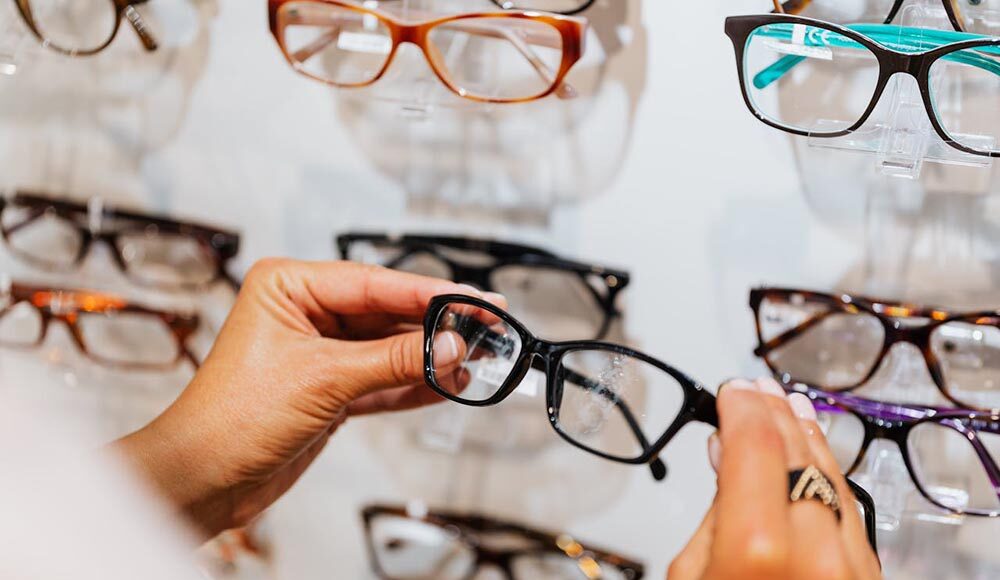Fast fashion isn’t just about clothing—eyewear waste is a hidden problem too.
Every year, millions of perfectly good glasses frames end up in landfills simply because their owners needed a prescription update or wanted to try new lens features. This throwaway culture in the eyewear industry creates an enormous environmental burden that most consumers never consider.
The statistics are staggering: millions of frames are discarded annually when prescriptions change, despite the frames themselves having years of life remaining. When you multiply this by the growing number of people who need vision correction worldwide, we’re looking at a sustainability crisis that rivals fast fashion’s environmental impact.
However, there’s a smarter solution gaining momentum amongst eco-conscious consumers and fashion enthusiasts alike. Re-lensing offers a greener, more economical way to refresh your glasses without contributing to waste. This innovative approach allows you to keep your favorite frames whilst updating your lenses with the latest prescriptions, coatings, and features.
In this comprehensive guide, you’ll discover everything you need to know about the re-lensing process, from understanding how it works to calculating your potential savings. We’ll explore the environmental benefits, walk through the technical process, and show you why re-lensing is becoming the go-to choice for smart consumers who refuse to choose between style, sustainability, and savings.
What Is Re-Lensing and How Does It Work?
Re-lensing, also known as reglazing glasses or lens replacement, is the process of removing old lenses from existing eyeglass frames and installing new prescription lenses in their place. This service breathes new life into your favorite frames, whether you need updated prescriptions, different lens materials, or enhanced features like blue light blocking or anti-glare coatings.
When you choose to replace lenses instead of buying entirely new glasses, you’re embracing a sustainable approach that maximizes the value of your existing frames.
Understanding Re-Lensing Services
The concept is beautifully straightforward: instead of buying an entirely new pair of glasses when your prescription changes, you simply replace the lenses while keeping the frames you love. This approach works with most frame types, from designer pieces to vintage finds, provided they’re structurally sound and properly sized for new lenses.
Types of frames suitable for re-lensing include:
- Full-rim metal and plastic frames
- Semi-rimless frames with secure lens grooves
- Most designer frames are in excellent condition
- Vintage frames with intact mounting systems
- Sports frames with standard lens mounting
The advantages of buying new glasses are substantial. You maintain your personal style with frames you’ve already chosen and grown to love, save significantly on costs, and reduce environmental waste. Moreover, if you have designer frames or sentimental favorites, re-lensing preserves these investments while giving you access to the latest optical technology.
Quality lens replacement services can accommodate nearly any prescription strength and offer the same lens options available in new glasses: single vision, progressive, bifocal, photochromic, polarized, and specialty lenses for specific needs like computer work or driving.
The Re-Lensing Process Explained
The process follows a precise sequence designed to protect your frames whilst ensuring perfect lens fitting. Professional opticians begin by carefully examining your frames for any damage or wear that might affect the lens installation.
Step 1: Frame Assessment and Measurement
Your frames undergo thorough inspection for structural integrity, and precise measurements are taken of the lens opening, bridge width, and temple length. This ensures the new lenses will fit perfectly and function properly with your specific frame geometry.
Step 2: Safe Lens Removal
Using specialized tools, skilled technicians carefully remove the existing lenses without damaging the frame. This requires considerable expertise, particularly with delicate materials like titanium or vintage acetate that may have become brittle over time.
Step 3: Prescription Verification and Lens Selection
Your new prescription is meticulously verified, and you choose from available lens options, including materials (plastic, polycarbonate, high-index), coatings (anti-reflective, scratch-resistant, blue light filtering), and treatments (photochromic, polarization).
Step 4: Lens Cutting and Shaping
New lenses are precisely cut and shaped to match your frame’s exact specifications. Advanced equipment ensures accuracy to within fractions of a millimeter, which is critical for proper vision correction and comfortable wear.
Step 5: Professional Installation and Quality Check
The new lenses are expertly installed in your frames, followed by comprehensive quality checks including optical alignment, secure mounting, and cosmetic inspection.
Timeframes typically range from 3-7 business days for standard prescriptions, with express services available for urgent needs. Complex prescriptions or specialty lenses may require additional time, but most projects are completed faster than ordering entirely new glasses.
Quality assurance includes verifying prescription accuracy, ensuring proper lens positioning, checking frame adjustments, and conducting final inspections for optical clarity and cosmetic perfection. Reputable services guarantee their work and will remake lenses if they don’t meet exact specifications.
Benefits of Re-Lensing for Consumers and the Planet
The advantages of choosing re-lensing extend far beyond simple cost savings, creating positive impacts for both individual consumers and our global environment. Understanding these benefits helps explain why sustainable eyewear practices are gaining remarkable momentum among informed consumers.
- Sustainability Impact
The environmental benefits are both profound and measurable. By choosing to reglaze glasses instead of purchasing new frames, you’re actively participating in the circular economy and reducing demand for resource-intensive manufacturing. - Waste Reduction
Every pair of frames saved from landfills prevents the disposal of complex materials, including metals, plastics, and composite materials that can take decades to decompose. The average pair of glasses frames contains materials that would otherwise contribute to the growing crisis of non-biodegradable waste. - Manufacturing Impact
Producing new eyeglass frames requires significant resources, including energy, raw materials, and water. The manufacturing process for acetate frames alone involves petroleum-based plastics, whilst metal frames require mining and processing of various alloys. Re-lensing eliminates the need for this resource-intensive production. - Carbon Footprint Reduction
Transportation, packaging, and retail distribution create substantial carbon emissions throughout the traditional glasses supply chain. Lens replacement services dramatically reduce these impacts by focusing only on optical components rather than complete products. - Extended Product Lifecycles
Quality frames can last for decades with proper care and maintenance. This approach allows you to maximize this impressive lifespan, transforming a typically disposable product into a genuine long-term investment. This perfectly aligns with sustainable consumption principles that prioritize durability and reuse over replacement. - Resource Conservation
The eyewear industry consumes significant amounts of specialized materials, including high-grade metals, engineered plastics, and precision components. By keeping frames in use longer through prescription lens replacement, we collectively reduce demand for these finite and often environmentally sensitive resources.
Consumer Advantages
The personal benefits make it an exceptionally attractive option even beyond environmental considerations. Savvy consumers increasingly recognize that this approach offers superior value whilst maintaining their preferred style and hard-earned comfort.
Substantial Cost Savings
Re-lensing typically costs 50-70% less than purchasing comparable new glasses from traditional retailers. For designer frames or specialty eyewear, the savings can be even more dramatic. A quality lens replacement service might charge £150-250 for premium progressive lenses that would cost £400-600 as part of a complete new glasses purchase.
Style Preservation
Many people develop strong preferences for specific frame styles, colors, or fits that perfectly suit their face shape and personal aesthetic. Re-lensing allows you to maintain these ideal matches whilst updating your optical needs. This proves particularly valuable for those with challenging prescriptions or distinctive style preferences.
Comfort Continuity
Frames that fit well and feel comfortable represent a significant personal investment in time and careful adjustment. Breaking in new frames, adjusting to different weights and proportions, and ensuring proper fit can take weeks or even months. This process preserves this hard-won comfort whilst providing updated vision correction.
Quality Frame Investment
High-quality frames often cost significantly more than their lenses, especially in designer or specialty categories. Re-lensing maximizes your return on this substantial investment by allowing you to use premium frames for many years across multiple prescription changes.
Faster Service
Many lens replacement services offer quicker turnaround times than traditional optical shops because they’re not managing extensive frame inventory or complex fitting processes. This operational efficiency directly benefits consumers who need updated glasses quickly.
Enhanced Customization Options
Services often provide more lens options and customizations than typical retail locations. You can upgrade to premium coatings, specialty tints, or advanced materials without being constrained by frame package deals or retail inventory limitations.
Re-Lensing in the Future of Eyewear Fashion

The movement is fundamentally reshaping how consumers and the fashion industry think about eyewear sustainability, creating compelling new trends that prioritize longevity and adaptability over throwaway convenience.
- Style and Fashion Appeal
Modern services are successfully elevating the practice from a simple cost-saving measure to a sophisticated fashion choice. Style-conscious consumers are discovering that the new lenses, old frames approach, offers unique advantages in personal expression and trend adaptation. - Designer Frame Investment
Luxury eyewear brands like Ray-Ban, Oliver Peoples, and Persol create frames specifically designed to last for years or even decades. Re-lensing allows fashion enthusiasts to confidently invest in premium frames knowing they can update prescriptions and lens technologies without replacing the entire piece. This intelligent approach transforms expensive designer glasses from short-term purchases into genuine long-term wardrobe investments. - Vintage and Unique Finds
The growing popularity of vintage eyewear has created an exciting market for unique frames from past decades. Prescription lens replacement makes it entirely possible to wear authentic vintage glasses with modern prescriptions and cutting-edge lens technologies. This trend particularly appeals to fashion-forward individuals who desire distinctive looks simply unavailable in contemporary retail. - Sustainable Fashion Statement
Choosing this approach has become a visible and meaningful way to demonstrate environmental consciousness. As sustainability becomes increasingly important in fashion choices, maintaining and updating existing frames sends a clear message about personal values and priorities. - Trend Adaptation
Fashion trends in lens treatments, coatings, and tints change regularly throughout the seasons. Re-lensing allows style-conscious wearers to experiment confidently with new looks—like blue light filtering, gradient tints, or photochromic technologies—without committing to entirely new frames. This flexibility actively encourages trend exploration whilst maintaining core style preferences.
Industry Adoption:
Forward-thinking companies across the eyewear industry are increasingly recognizing this service as both an environmental necessity and a significant business opportunity, leading to broader adoption and continuously improved service quality.
- Retailer Integration
Traditional optical chains are beginning to offer comprehensive glasses repair and lens replacement services alongside their established new product lines. This strategic shift acknowledges growing consumer demand for sustainable options and creates valuable new revenue streams from existing customer relationships. - Technology Investment
Advanced lens cutting and fitting equipment is making the process more precise, reliable, and accessible than ever before. Digital measurement systems, automated edging machines, and improved quality control processes ensure that lens replacement services can match or exceed the quality of new glasses production. - Service Innovation
Specialized online platforms are streamlining the entire process with convenient mail-in services, virtual consultations, and detailed online prescription management. These technological innovations make sustainable eyewear choices more convenient and accessible than traditional retail alternatives. - Professional Development
Opticians and technicians are receiving increasingly specialized training in frame assessment, careful lens removal, and precision installation techniques. This substantial investment in skills development ensures that services maintain consistently high-quality standards whilst handling diverse frame types and complex prescription requirements.
Making the Smart Choice: Your Re-Lensing Journey
Choosing re-lensing over new glasses represents more than a simple transaction—it’s a thoughtful decision that reflects your values, priorities, and understanding of sustainable consumption. As this practice gains mainstream momentum, early adopters discover that environmental responsibility and personal satisfaction can align perfectly.
The quality of lens replacement services has evolved dramatically in recent years, with many providers now offering guarantees that match or exceed those of traditional optical retailers. Advanced equipment, skilled technicians, and refined processes ensure that your refreshed glasses will meet the same exacting standards as new purchases whilst delivering superior value.
This approach also offers unique opportunities for personalization that traditional retail often can’t match. Without the constraints of frame selection, you can focus entirely on optimizing your lens specifications—choosing premium materials, advanced coatings, or specialty treatments that might be cost-prohibitive with new glasses purchases. This freedom allows for true customization based on your specific vision needs and lifestyle requirements.
Ready to start your journey?
Begin by carefully assessing your current frames for structural integrity and style satisfaction. Research reputable services in your area or online, compare pricing and service options, and gather your current prescription information. Most quality services offer free consultations to determine if your frames are suitable for lens replacement and provide detailed quotes for your specific needs.
Consider factors like turnaround time, warranty coverage, lens options available, and customer reviews when selecting a provider. Many services offer convenient mail-in options, making the process remarkably simple even if local providers aren’t available.
The investment in understanding your options will pay dividends in both satisfaction and savings. Take time to explore different lens technologies and treatments that might enhance your vision experience—from advanced anti-reflective coatings that reduce eye strain to photochromic lenses that adapt to changing light conditions.
Conclusion
Re-lensing represents a genuine paradigm shift in how we approach eyewear consumption, offering a sustainable solution that simultaneously benefits consumers and the environment. By choosing to update your lenses whilst preserving your favorite frames, you’re making a financially intelligent decision that can save you hundreds of pounds whilst significantly reducing your environmental footprint.
The process is straightforward, reliable, and increasingly accessible through both innovative online services and progressive traditional optical retailers. Whether you’re motivated by substantial cost savings, environmental consciousness, or simply love your current frames, re-lensing provides a practical and satisfying alternative to the wasteful cycle of complete glasses replacement.
As the eyewear industry continues evolving towards more sustainable practices, lens replacement services are becoming increasingly sophisticated, offering the same quality, options, and guarantees available with new glasses purchases. This evolution ensures that choosing sustainability never means compromising on style, comfort, or optical excellence.
The future of sustainable eyewear begins with individual choices made today. By choosing re-lensing, you’re not simply saving money; you’re actively contributing to a more sustainable approach to vision correction that preserves valuable resources, reduces unnecessary waste, and proves that environmental responsibility and personal style can work together in perfect harmony.
Transform your approach to eyewear today and discover why thousands of smart consumers are making the switch to this sustainable, stylish, and economical solution. The choice is clear: keep what you love, upgrade what you need, and make a positive impact on both your wallet and the world.
##





